Measuring just 6.8″ the CarolBrass CPT-1000-YSS-Bb-S Mini Pocket Trumpet is probably the smallest playable Bb trumpet in production. The mini pocket trumpet has a specially designed small yellow brass bell and light weight construction. This is the ideal travel trumpet for those times when space is at a premium. The CarolBrass CPT-1000-YSS-Bb-S Mini Pocket Trumpet features the same stainless steel valves as the rest of the CarolBrass line. Also available in C!
Carol Brass Mini Pocket Trumpet CPT-1000 (Bb)
Nick DeCarlis
PocketCornets.com and Author of Pocket
Cornets & Trumpets: Actual Size
Due to my continuing fascination with, and collecting of, pocket cornets and trumpets, I was asked to review the new CPT-1000 Mini Pocket Trumpet.
The Packaging
My first impression was that of the package delivered to my door, just 10″ x 10″ x 6″! It seemed more appropriate for shipping a large mute than an actual trumpet! Inside was an even smaller soft carrying case, and accessories, including a shoulder strap, polycarbonate mouthpiece, valve oil, and care booklet. The case is very nicely made, with a nylon strap handle, and zippered side compartment large enough to hold the optional shoulder strap, valve oil and mouthpiece. The case measures 8″ x 7″ x 6″. Mine is black with white piping trim, although blue, red and white piping are available. Upon opening the case I found dense padding on all sides, of 3/4″ thickness.
Background (and is it really the world’s smallest?)
By definition, any pocket trumpet or cornet is smaller than a conventional instrument of the same type and pitch. Yet within that definition, there can be a surprising range of dimensions, to the extent that some pocket trumpets are more than 10″ in length (mouthpiece removed). Include a bell with a normal bell diameter (~ 5.0″), and the resulting instrument won’t seem that much smaller than a compactly designed (but non-pocket) cornet. After all, the whole point of making a pocket instrument is for effect, either practical or visual, so the smaller the better. Average length (again, mouthpiece removed) is typically in the range of 8.75″ to 9.75″. What greeted me is an extraordinarily small instrument, one that measures just 6.75″ in length (2+ inches shorter than average), with a bell diameter of 3.75″. How small is that, historically speaking, as pocket instruments go? It happens to be the same length as the well-known, but incredibly rare, Holton C150 pocket cornet—an instrument discontinued when Holton ended trumpet production in Elkhorn, WI. The C150 was very closely patterned after the Philadelphia Distin “Baby” cornet won by Herbert Clarke in 1886 (who later had a long association with Holton). Even back in the late 19th century, when many companies made pocket cornets, the “Baby” was the smallest of them all. For many years, the C150 was touted as the world’s smallest pocket cornet. But the C150 has been out of production for some fifteen years, and even then, extremely few were ever produced. That being the case, the CPT-1000 is truly the world’s smallest pocket trumpet currently in production. Admittedly, we are talking about differences of a few inches, or even fractions of an inch. But when one considers the primary factors for wanting a pocket trumpet, this can be important. Use as a “travel trumpet” is often cited. If that’s the desired use, the CPT-1000’s case will fit easily in any suitcase and take up less space than many shaving cases. If the goal is “cool factor” during a live performance, then a pocket barely larger than your hand will have the desired effect. Carol Brass must certainly have had small children in mind as well. In recent years, unfortunately, school band directors have all but abandoned cornets for beginners, forcing youngsters to hold full-length trumpets out at arm’s length. The further the horn is held out, the heavier it will seem to become as time passes. Such a short trumpet is held quite close, and thus far more easily. This market likely dictated the three color choices for case piping. Due to the proliferation of cheaply made (and barely playable) pocket trumpets available online, it may be a challenge to convince band directors that the Mini Pocket Trumpet should be considered the exception and quite suitable for students.
Construction
The construction quality is quite good, even for a professional level instrument, let alone one sold at this price point. I saw no flaws whatever with soldering or lacquer. I’ve owned other Hoxon instruments and always been impressed with the workmanship. The valve action is just as I prefer it — fast and light with no signs of “hanging up” — in other words, no use of heavy springs to overcome slow or sticky valve pistons. I feel this aspect is the first and most important indication of quality for most players, and Hoxon gets high marks here. The third slide throw is a typical style found on pocket trumpets — a crook close in size to the tuning slide which extends towards the mouthpiece, and is actuated by the left thumb. I’m not particularly fond of this style, as the greater the distance between the slide tubes (and thus wider crook), the more difficult it is to get smooth action. However, on pocket trumpets it must be pointed out that the design options for third or first valve throws are limited by the general “congestion” of tubing. One interesting design feature is that the first valve slide leaves the casing straight back as usual, but then turns up at 90 degrees, so that it does not extend past the bell crook. This is a very seldom seen feature on pocket instruments. Two waterkeys are provided, and appear to be a proprietary design similar to Amado keys, with one nice difference — opposite the push button is a screw off cap, evidently to allow for lubrication, cleaning, or replacement of the spring. The Mini comes with a polycarbonate trumpet mouthpiece with a relatively deep cup (compared to typical trumpet mouthpieces). After trying a variety of mouthpieces I had on hand, I concluded the provided mouthpiece was quite well matched to the horn.
How does it play?
I’m asked this all the time, and there isn’t a more subjective question, depending on considerations ranging from player proficiency to the type of music played. The Mini is fairly easy to hold, as pockets go. Some can be quite awkward, especially so
with smaller pockets due to the even tighter wrap. In fact, the Holton C150 is one of the hardest to find a comfortable hand hold. So the Mini gets points for being the same size, yet much easier to grasp. In general I found the Mini an easy trumpet to play, especially in the upper register (full disclosure: “high notes” for me are, say, G above the staff). However, I found the lowest register to be weak, from low C on down — a response not unlike that found on an old cornet or trumpet with worn (and leaking) valve pistons. Of course, there is no such issue with the Mini’s valves, which seal perfectly, with no signs of leaking. I recently had the opportunity to share the Mini with several professional trumpeter friends who were very impressed with how it played, but all noted the low register issue. Having only played this one example, I have no way of knowing if all Mini’s exhibit this characteristic or if it was specific to my test instrument. For many trumpeters, low C and down are notes seldom called upon, so this may not be an issue. But it may be one for beginners. I found the Mini’s tone to be fairly bright. But I’ve learned that the way a pocket sounds to the player (whose ears are much closer than usual to the bell) can be quite different than how it sounds when you hear somebody else playing it. When I heard others try the Mini, I thought the tone sounded quite normal. However, I would suggest that the tonal quality of the Mini depends greatly on the mouthpiece used, whereas some trumpets and cornets seem to maintain their basic tonal characteristics regardless of mouthpiece. This may be due in some part to the smaller bell diameter and narrow throat taper. I believe it benefits from a slightly deeper than usual cup, as demonstrated by the provided polycarbonate mouthpiece. I also tried playing the Mini with my usual deep-V cup Yamaha cornet mouthpiece and a Reeves cornet-to-trumpet adapter, which worked quite well.
Conclusions
Hoxon Gakki, more than any company in the world, has done much to elevate the quality of easily available pocket trumpets while providing them at a price where players can rationalize the purchase of a second horn to complement their primary player. I’ve corresponded with many musicians interested in acquiring a pocket trumpet, but only if they can find one that plays like a professional model without the “professional price tag”. High expectations indeed to make of any trumpet, let alone a pocket with the smallest dimensions of any currently manufactured! The Hoxon Mini Pocket Trumpet is clearly a lot of “bang for the buck,” with a suggested retail price of $475. That puts it in the range of student model trumpets — while providing construction quality of instruments costing much more. An instrument at this price point is unlikely to become a professional’s primary player — but for practice while traveling, young students, the occasional gig, or a few songs over the course of a gig, the Mini Pocket Trumpet will do an admirable job… and garner more than a few smiles from listeners along the way.

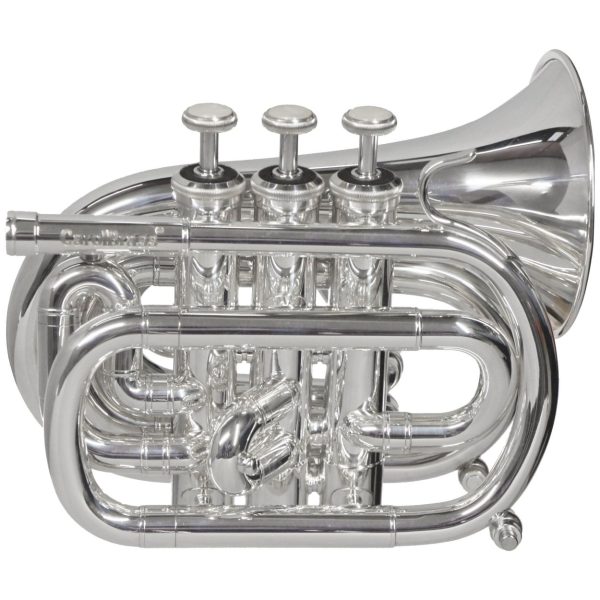
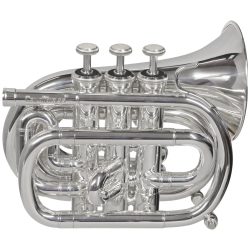

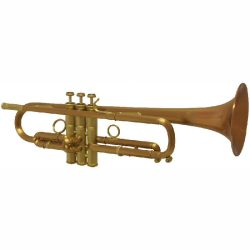
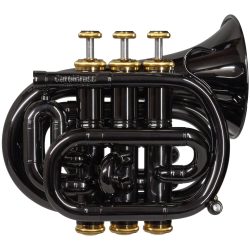
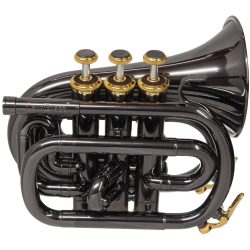
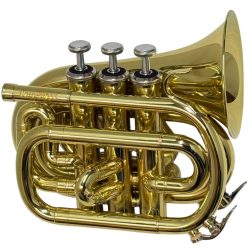
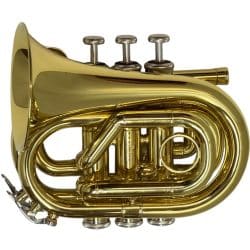
Reviews
There are no reviews yet.